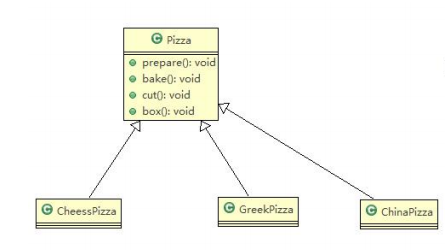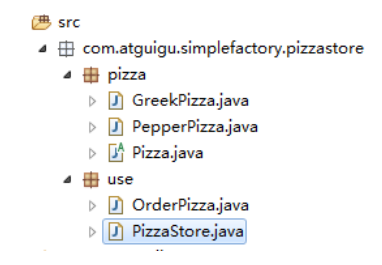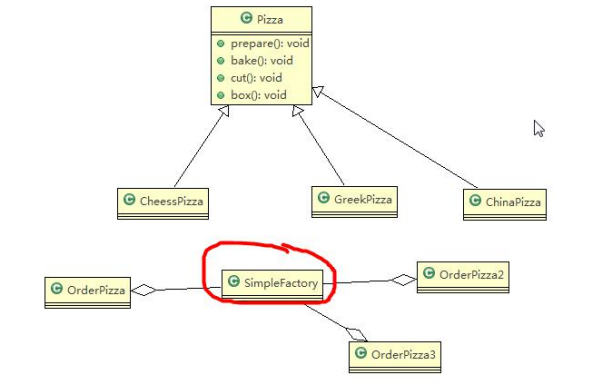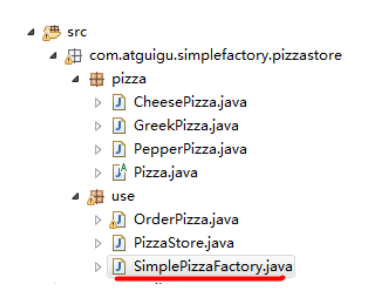Simple factory mode
Look at a specific need
Look at a pizza project: it should be convenient for the expansion of pizza types and maintenance
-
There are many kinds of pizza (such as greenpizza, cheese pizza, etc.)
-
Pizza making includes prepare, bake, cut and box
-
Complete the pizza shop ordering function.
Use the traditional way to complete
-
Train of thought analysis (class diagram)


-
Code demonstration
Abstract pizza class:
package com.atguigu.factory.simplefactory.pizzastore.pizza; //take Pizza Make class abstract public abstract class Pizza { protected String name; //name //Prepare raw materials, Different pizza is different, so we make it abstract public abstract void prepare(); public void bake() { System.out.println(name + " baking;"); } public void cut() { System.out.println(name + " cutting;"); } //pack public void box() { System.out.println(name + " boxing;"); } public void setName(String name) { this.name = name; } }
Cheese pizza, inheriting Abstract pizza class:
package com.atguigu.factory.simplefactory.pizzastore.pizza; public class CheesePizza extends Pizza { @Override public void prepare() { // TODO Auto-generated method stub System.out.println(" Prepare raw materials for making cheese pizza "); } }
Greek pizza, inherited pizza class:
package com.atguigu.factory.simplefactory.pizzastore.pizza; public class GreekPizza extends Pizza { @Override public void prepare() { // TODO Auto-generated method stub System.out.println(" Prepare raw materials for Greek pizza "); } }
Order pizza:
package com.atguigu.factory.simplefactory.pizzastore.order; import java.io.BufferedReader; import java.io.IOException; import java.io.InputStreamReader; import com.atguigu.factory.simplefactory.pizzastore.pizza.Pizza; public class OrderPizza { // constructor public OrderPizza() { Pizza pizza = null; String orderType; // Type of pizza ordered do { orderType = getType(); if (orderType.equals("greek")) { pizza = new GreekPizza(); pizza.setName(" Greek pizza "); } else if (orderType.equals("cheese")) { pizza = new CheesePizza(); pizza.setName(" Cheese pizza "); }else { break; } //output pizza Production process pizza.prepare(); pizza.bake(); pizza.cut(); pizza.box(); } while (true); } // Write a method to get the type of pizza customers want to order private String getType() { try { BufferedReader strin = new BufferedReader(new InputStreamReader(System.in)); System.out.println("input pizza type:"); String str = strin.readLine(); return str; } catch (IOException e) { e.printStackTrace(); return ""; } } }
client:
package com.atguigu.factory.simplefactory.pizzastore.order; //It is equivalent to a client and sends out an order public class PizzaStore { public static void main(String[] args) { new OrderPizza(); } }
Advantages and disadvantages of traditional methods:
-
The advantages are easy to understand, simple and easy to operate.
-
The disadvantage is that it violates the ocp principle of design pattern, that is, it is open to extension and closed to modification. That is, when we add new functions to the class, we try not to modify the code, or modify the code as little as possible
-
For example, if we want to add a new Pizza (Pepper Pizza), we need to make the following modifications
code:
Order pizza:
package com.atguigu.factory.simplefactory.pizzastore.order; import java.io.BufferedReader; import java.io.IOException; import java.io.InputStreamReader; import com.atguigu.factory.simplefactory.pizzastore.pizza.Pizza; public class OrderPizza { // constructor public OrderPizza() { Pizza pizza = null; String orderType; // Type of pizza ordered do { orderType = getType(); if (orderType.equals("greek")) { pizza = new GreekPizza(); pizza.setName(" Greek pizza "); } else if (orderType.equals("cheese")) { pizza = new CheesePizza(); pizza.setName(" Cheese pizza "); } else if (orderType.equals("pepper")) { pizza = new PepperPizza(); pizza.setName("Pepper pizza"); } else { break; } //output pizza Production process pizza.prepare(); pizza.bake(); pizza.cut(); pizza.box(); } while (true); } // Write a method to get the type of pizza customers want to order private String getType() { try { BufferedReader strin = new BufferedReader(new InputStreamReader(System.in)); System.out.println("input pizza type:"); String str = strin.readLine(); return str; } catch (IOException e) { e.printStackTrace(); return ""; } } }
Pepper pizza:
package com.atguigu.factory.simplefactory.pizzastore.pizza; public class PepperPizza extends Pizza { @Override public void prepare() { // TODO Auto-generated method stub System.out.println(" Prepare raw materials for pepper pizza "); } }
4. Analysis of improvement ideas
Analysis: it is acceptable to modify the code, but if we also have the code to create Pizza in other places, it means that we also need to modify it, and the code to create Pizza often has many places.
Idea: encapsulate the created Pizza object into a class, so that when we have a new Pizza type, we only need to modify the class, and other codes that create Pizza objects do not need to be modified. - > Simple factory mode
Basic introduction to simple factory mode
-
The simple factory mode belongs to the creation mode, which is a kind of factory mode. The simple factory pattern is a factory object that determines which product class instance to create. The simple factory pattern is the simplest and most practical pattern in the factory pattern family
-
Simple factory pattern: defines a class for creating objects, which encapsulates the behavior (code) of instantiating objects
-
In software development, when we will use a lot of to create a, a class or a batch of objects, we will use the factory pattern
Use of simple factory mode
-
Design scheme of simple factory pattern: define a class that can instantiate Pizaa objects and encapsulate the code to create objects.
-
Train of thought analysis


code:
Simple factory class:
package com.atguigu.factory.simplefactory.pizzastore.order; import com.atguigu.factory.simplefactory.pizzastore.pizza.CheesePizza; import com.atguigu.factory.simplefactory.pizzastore.pizza.GreekPizza; import com.atguigu.factory.simplefactory.pizzastore.pizza.PepperPizza; import com.atguigu.factory.simplefactory.pizzastore.pizza.Pizza; //Simple factory class public class SimpleFactory { //More orderType Return the corresponding Pizza object //Simple factory mode is also called static factory mode public Pizza createPizza(String orderType) { Pizza pizza = null; System.out.println("Use simple factory mode"); if (orderType.equals("greek")) { pizza = new GreekPizza(); pizza.setName(" Greek pizza "); } else if (orderType.equals("cheese")) { pizza = new CheesePizza(); pizza.setName(" Cheese pizza "); } else if (orderType.equals("pepper")) { pizza = new PepperPizza(); pizza.setName("Pepper pizza"); } return pizza; } }
Order pizza:
package com.atguigu.factory.simplefactory.pizzastore.order; import java.io.BufferedReader; import java.io.IOException; import java.io.InputStreamReader; import com.atguigu.factory.simplefactory.pizzastore.pizza.Pizza; public class OrderPizza { //Define a simple factory object SimpleFactory simpleFactory; Pizza pizza = null; //constructor public OrderPizza(SimpleFactory simpleFactory) { setFactory(simpleFactory); } public void setFactory(SimpleFactory simpleFactory) { String orderType = ""; //User entered this.simpleFactory = simpleFactory; //Set simple factory object do { orderType = getType(); pizza = this.simpleFactory.createPizza(orderType); //output pizza if(pizza != null) { //Order succeeded pizza.prepare(); pizza.bake(); pizza.cut(); pizza.box(); } else { System.out.println(" Failed to order pizza "); break; } }while(true); } // Write a method to get the type of pizza customers want to order private String getType() { try { BufferedReader strin = new BufferedReader(new InputStreamReader(System.in)); System.out.println("input pizza type:"); String str = strin.readLine(); return str; } catch (IOException e) { e.printStackTrace(); return ""; } } }
client:
package com.atguigu.factory.simplefactory.pizzastore.order; //It is equivalent to a client and sends out a subscription public class PizzaStore { public static void main(String[] args) { //Use simple factory mode new OrderPizza(new SimpleFactory()); System.out.println("~~Exit program~~"); } }